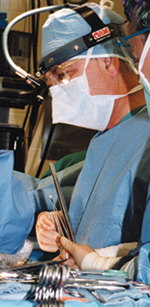Reducing Blood Loss in Open Radical Retropubic Prostatectomy (RRP)

Blood loss during any operation can affect the surgeon’s view of and access to the area of concern. It can also affect the recovery time and general “well being” of the patient.
A better understanding of the male pelvic blood supply and nerve anatomy has led to less blood loss for radical prostatectomy patients, resulting in better potency and continence outcomes.
That notwithstanding, blood loss during open RP can be substantial, and any measure that helps reduce blood loss would be useful to surgeons and beneficial to patients.
Laparoscopic RRP has its particular concerns as well. The introduction of laparoscopic techniques and the more recent advent of robotic-assisted laparoscopic RP have been association with less blood loss than with an open RRP, but electrocautery or the harmonic scalpel are often used to help control bleeding during laparoscopic and robotic RP, with the potential for heat damage to the cavernous neurovascular bundles (NVBs) responsible for erectile potency.
Using sutures involves no heat and therefore less potential for damaging the nerve bundles and affecting potency. Improving this technique for less bleeding in open RRP  makes for easier recovery and can result in even better potency and continence.
makes for easier recovery and can result in even better potency and continence.

The objective was to identify ways to reduce the blood loss associated with open RRP (Catalona). With sutures carefully placed around the area of the prostate before proceeding with removal, a good amount of the bleeding was stopped before it began. The catgut sutures are tied with the least amount of tension possible to prevent bleeding while potentially minimizing tissue damage, and catgut is used because it is rapidly absorbed.
The placement of the sutures does not lead to an increase in operation time because the pre-placement reduces the time later spent stopping the bleeding after the prostate has been mobilized and removed.
Because this technique was only recently adopted (Catalona 2007), the present follow-up is not yet sufficiently mature to examine the long-term effects on potency, continence, and cancer control. That follow-up is necessary.
But due to the short-term advantage of reduced blood loss, we (Catalona) continue to place these sutures during open RRP.
Because this preventive use of sutures results in significantly reduced blood loss during RRP, the information and the technique may be useful for other surgeons.
(For the published article see: Reducing blood loss in open radical retropubic prostatectomy with prophylactic periprostatic sutures; ©2009 BJU International; Gustavor F. Carvalhal, MD; Christopher Griffin, Donghui Kan, Stacy Loeb, MD; William J. Catalona, MD











